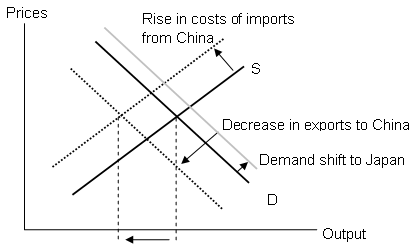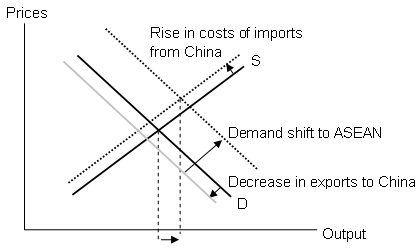Severe Acute Respiratory Syndrome (SARS) is wreaking havoc in Asia, especially in China. Should the Chinese economy lose steam and some factories be forced to suspend operations as a result of the epidemic, it would likely affect other Asian nations whose economies are closely linked to that of China, such as Japan. The negative impact of such an outcome would be greater for Japan and the Newly Industrialized Economies, which are in a complementary relationship with China, than for the members of the Association of Southeast Asian Nations, which are in competition with China.
If a decline in production in China can be compensated by increasing production in Japan, it would help support the Japanese economy. However, when we consider how few products made by Japan and China actually compete with each other, the effects of such a production shift seem limited (the demand curve will shift to the right, but only slightly). In contrast, should the Chinese economy slow down as a result of SARS, it is probable that Japan's exports to China will decrease (the demand curve will shift sharply to the left). Most of Japan's exports to China are in the form of machinery and parts, and any changes in demand are likely to be concentrated in these industries. When we combine the effects of this increase and decrease in demand, we can forecast that Japan's overall output will no doubt decrease. Likewise, service-related industries, such as tourism and airlines, have been dealt a serious blow by the sharp decline in the passenger traffic between Japan and China, despite the slight compensation from an increase in domestic travel.
Furthermore, factors pertaining to supply will also work to the disadvantage of Japan's output. In many industries, especially those where modularization has progressed, such as electrical appliances and personal computers, there is a division of labor among production processes between Japan and China. Should the supply of order-made parts from China be cut off, its effects would be far-reaching due to interwoven structure of input and output. Even in cases where substitute products can be found for those made in China, prices will rise if there is a shortfall in supply. For Japanese firms, this signifies a rise in production costs, and becomes a factor that dampens output (the supply curve shifts sharply to the left).
The conclusion that changes in both demand and supply will have a negative effect on industry and economy also applies to the NIEs, which like Japan are in a complementary relationship with China. However, Hong Kong, Taiwan and Singapore are all directly affected by the SARS epidemic and it goes needless to say that the situation in those economies is more serious than in Japan.
By contrast, the industrial structures of the ASEAN nations are similar to that of China, and furthermore, are in a competitive relationship with China. On the demand front, their dependence on exports to China is low, and so even if China-bound exports fell due to the slowdown of the Chinese economy, the impact on total exports - and thus the total economy - would be relatively small (the leftward shift of the demand curve would be small). On the contrary, ASEAN countries will probably enter the spotlight and take China's place as recipient of orders placed by transnational corporations (the demand curve will shift sharply to the right). Meanwhile, in terms of supply their dependency on intermediate input (for example, parts from China) is low, and impact will be limited (the supply curve will shift to the left, but only slightly). When all of these effects are taken into account, we can see that ASEAN's output will not shrink, but in fact may even expand.
The fact that ASEAN and China are in a competitive relationship also means that they are close substitutes for each other, not just as recipients of production orders but also of direct investment. Over the past few years, Japanese investment in China has been booming, but the recent turn of events will likely lead many firms to review their investment strategies. In fact, the idea that overseas investments should not be excessively concentrated in China, from the viewpoint of risk diversification, was floated among Japanese firms even before the epidemic began. With the specific appearance of risk in the form of SARS, the brakes will probably be put on the shift of direct investment from ASEAN to China.
Just like during the Asian financial crisis of 1997 to 1998, the effects of SARS are not only limited to the country of origin but also affect all neighboring countries. This is not only evidence that Asian economies are closely linked through the flow of people, goods and capital, but also underscores the need for economic cooperation among all countries in the region - not just in battling disease, but on the trade, finance and monetary fronts - so as to achieve regional stability and prosperity.
Diagram : The effects of SARS on Asian economies
a) Japan

b) ASEAN



